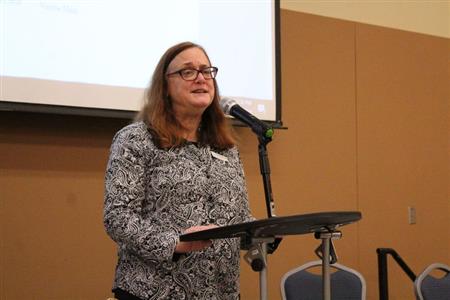“We never turn away an animal in need.”
That’s what Peggy Brown, community outreach coordinator for the Humane Society of North Texas, told members of the Cleburne Rotary Club on Thursday at the Cleburne Conference Center.
Founded in 1905, the HSNT is the oldest animal welfare organization in the Dallas-Fort Worth Metroplex.
.jpg)
“We never turn away an animal in need.”
That’s what Peggy Brown, community outreach coordinator for the Humane Society of North Texas, told members of the Cleburne Rotary Club on Thursday at the Cleburne Conference Center.
Founded in 1905, the HSNT is the oldest animal welfare organization in the Dallas-Fort Worth Metroplex.
Brown said they are an open admission shelter, which means they accept any animal that comes through the front door and never turns them away.
The shelter carries mostly dogs and cats, but she said they’ve also received livestock, small animals like hamsters and rabbits and even a few reptiles. The most bizarre animals she’s seen come through the shelter have been camels, bears and a tiger.
Earlier this month, more than 300 malnourished longhorn and crossbreed cattle were seized from a 43-acre ranch in Hill County and have found temporary solace in various places, including Johnson County.
Brown said they have custody of the 338 cattle right now and are waiting on the judge to decide what to do with them. Until then, they and various ranches around north Texas are taking care of them.
We’ve helped with law enforcement with animal cruelty cases in the past and continue to do so, she said.
In the 14 years she’s been with the organization, she said there’s never been a dull moment.
With her position at the shelter, she said her job is to educate the public how to take care of animals properly, especially children.
“When I go to schools, I teach kids about how to be responsible with a pet,” she said. “It’s about teaching kids about safety.”
When children meet a new animal, they shouldn’t run up and hug or grab them because most animals aren’t use to being handled that way.
Children don’t need to look dogs in the eyes when they first meet them because the dog might take that as a challenge, she said. When dogs make eye contact with other dogs, that usually means they want to fight.
“When I have people come to the shelter, they ask if we have dogs that are good with children,” she said. “What I ask is if their kids are good with dogs.”
She also educates the public on how important it is for pet owners to spay or neuter their pets to keep the pet population down.
“We do this to prevent more puppies and kittens from popping up,” she said. “Many people don’t realize that a cat or dog can start having babies when they are 6 months old. In the spring, we call it puppy and kitten season because we will receive boxes of them day after day.”
The shelter also has a feral cat program. If residents see a feral cat and can safely grab them, they can bring them to the shelter where they will spay or neuter them before they’re released back, she said.
“We have wonderful animals available,” she said. “When most people think of buying an animal from a shelter, they think they’re broken.”
About 30 percent of dogs that come into the shelter are purebred, she said.
If someone wants to have a dog or cat, she said they should visit the shelter first. If they don’t have it one day, they might have it the next day.
For more information about the shelter, visit hsnt.org.

